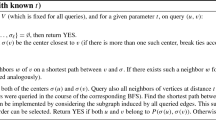Abstract
In this paper we consider the problem of partitioning large sparse graphs, such as finite element meshes. The heuristic which is proposed allows to partition into connected and quasi-balanced subgraphs in a reasonable amount of time, while attempting to minimize the number of edge cuts. Here the goal is to build partitions for graphs containing large numbers of nodes and edges, in practice at least 104. Basically, the algorithm relies on the iterative construction of connected subgraphs. This construction is achieved by successively exploring clusters of nodes called fronts. Indeed, a judicious use of fronts ensures the connectivity of the subsets at low cost: it is shown that locally, i.e. for a given subgraph, the complexity of such operations grows at most linearly with the number of edges. Moreover, a few examples are given to illustrate the quality and speed of the heuristic.
Similar content being viewed by others
References
C.J. Alpert and A.B. Kahng, Multi-way partitioning via spacefilling curves and dynamic programming, in:31st Design Automation Conference (ACM/IEEE, 1994) pp. 652–657.
S.T. Barnard and H.D. Simon, A fast multilevel implementation of recursive spectral bisection for partitioning unstructured problems, Technical report, NASA Ames Research Center, RNR092-033 (1992).
E.R. Barnes, An algorithm for partitioning the nodes of a graph, SIAM J. Alg. Discr. Meth. 3 (1982) 541–550.
E.R. Barnes, A. Vannelli and J.Q. Walker, A new heuristic for partitioning the nodes of a graph, SIAM J. Discr. Meth. 1 (1988) 299–305.
C. Berge,Graphes (Gauthier-Villars, Paris, 1983).
T.N. Bui, S. Chaudhuri, F.T. Leighton and M. Sipser, Graph bisection algorithm with good average case behavior, Combinatorica (1987) 171–191.
N. Chistofides and P. Brooker, The optimal partitioning of graphs, SIAM J. Appl. Math.30 (1976) 55–69.
P. Ciarlet, Jr. and F. Lamour, Un algorithme rapide de partitionnement automatique de graphes, Technical report, CEA N-2738 (1993).
P. Ciarlet, Jr. and F. Lamour, An efficient low cost greedy graph partitioning heuristic, Technical report, UCLA, CAM 94-1 (1994).
P. Ciarlet, Jr. and F. Lamour, Recursive partitioning methods and greedy partitioning methods: a comparison on finite element graphs, Technical report, UCLA, CAM 94-9 (1994).
P. Ciarlet, Jr., F. Lamour and B.F. Smith, On the influence of the partitioning schemes on the efficiency of overlapping domain decomposition methods, in:5th Symp. on the Frontiers of Massively Parallel Computation (IEEE, 1995) pp. 375–384.
S. Dutt, New faster Kernighan-Lin graph partitioning algorithms, in:Int. Conf on CAD-93 (IEEE/ACM, 1993) pp. 370–377.
C. Farhat, A simple and efficient automatic FEM domain decomposer, Comp. Structures 28 (1988) 579–602.
C. Farhat and H.D. Simon, TOP/DOMDEC — a software tool for mesh partitioning and parallel processing, Technical report, NASA Ames Research Center, RNR-93-011 (1993).
C.M. Fiduccia and R.M. Mattheyses, A linear-time heuristic for improving network partitions, in:19th Design Automation Conf (IEEE, 1982), pp. 175–181.
M. Fiedler, Algebraic connectivity of graphs, Czech. Math. J. 23 (1973) 298–305.
L.R. Foulds,Graph Theory Applications (Springer, 1992).
A. George and J.W.H. Liu, An automatic nested dissection algorithm for irregular finite element problems, SIAM J. Numer. Anal. 15 (1978) 1053–1069.
L. Hagen and A.B. Kahng, A new approach to effective circuit clustering, in:IEEE/ACM Int. Conf. on Computer-Aided Design, (IEEE, 1992), pp. 422–427.
L. Hagen and A.B. Kahng, New spectral methods for ratio cut partitioning and clustering, IEEE Trans. Comp. Aided Design 11 (1992) 1074–1085.
B. Hendrickson and R. Leland, An improved spectral graph algorithm for mapping parallel computations, Technical report, Sandia, SAND 92-1460 (1992).
B. Hendrickson and R. Leland, Multidimensional spectral load balancing Technical report, Sandia, SAND 93-0074 (1993).
B. Hendrickson and R. Leland, A multilevel algorithm for partitioning graphs, Technical report, Sandia, SAND 93-1301 (1993).
B.W. Kernighan and S. Liu, An efficient heuristic for partitioning graphs, Bell Syst. Techn. 49 (1970) 291–307.
J.W.H. Liu, A graph partitioning algorithm by node separators, ACM Trans. Math. Softw. 15 (1989) 198–219.
G.L. Miller, S-H. Teng, W. Thurston and S.A. Vavasis, Automatic mesh partitioning, in:Graph Theory and Sparse Matrix Computations (Springer, 1993) pp. 57–84.
A. Pothen, H.D. Simon and K.P. Liou, Partitioning sparse matrices with eigenvectors of graphs, SIAM J. Matrix Anal. Appl. 11 (1990) 430–452.
F. Rendl and H. Wolkowicz, A projection technique for partitioning the nodes of a graph, Technical report, University of Waterloo, CORR 90-20 (1990).
C. Roucairol and P. Hansen, Problème de la bipartition minimale d'un graphe. RAIRO 21 (1987) 325–348.
H.D. Simon, Partitioning of unstructured problems for parallel processing, Comp. Syst. Eng. 2 (1991) 135–148.
Author information
Authors and Affiliations
Additional information
Communicated by C. Brezinski
The work of this author was partially supported by the DGA/DRET under contract 93-1192 and by the Army Research Office under contract DAAL03-91-C-0047 (Univ. Tenn. subcontract ORA4466.04 Amendment 1).
The work of this author was partially supported by the National Science Foundation under contract ASC 92-01266, the Army Research Office under contract DAAL03-91C-0047 (Univ. Tenn. subcontract ORA4466.04 Amendment 1), and ONR under contract ONR-N00014-92-J-1890.
Rights and permissions
About this article
Cite this article
Ciarlet, P., Lamour, F. On the validity of a front-oriented approach to partitioning large sparse graphs with a connectivity constraint. Numer Algor 12, 193–214 (1996). https://doi.org/10.1007/BF02141748
Received:
Revised:
Issue Date:
DOI: https://doi.org/10.1007/BF02141748




